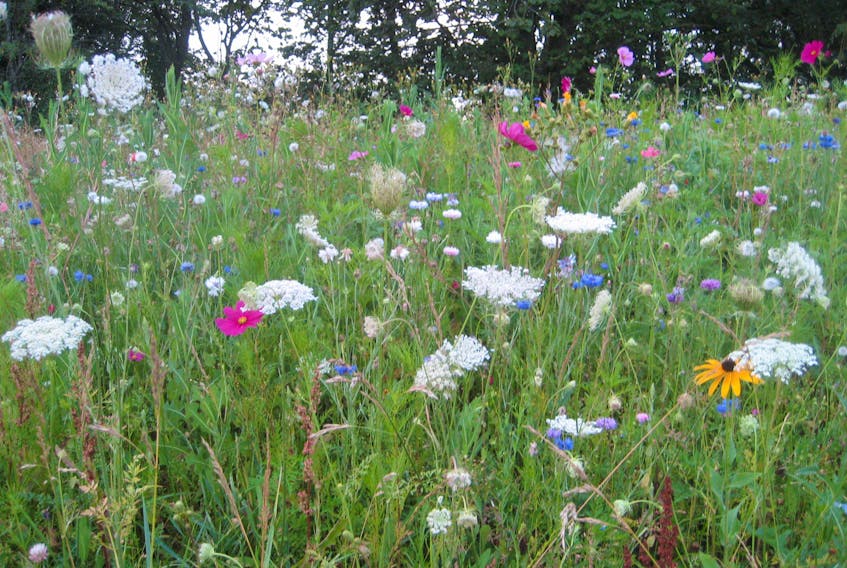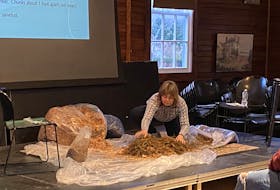Lawns have a place. They create great pathways, activity areas and frame a garden perfectly.
Some people see a world of athletic potential: baseball diamonds and soccer fields. We tend not to be an athletic family. Ben would tell you that his athletic career peaked with a soccer participation medal at age eight. Like father, like son.

Instead, we tend to frolic. And where better to frolic than in wide-open meadows?
Stop amid a flowering meadow on a still day and you are sure to hear a chorus of happy birds and pollinators, many of which can be threatened species, hanging on by a thread in the margins of over-developed urban landscape.
A mature meadow is virtually maintenance free. A gardener occasionally steps in to knock down the most aggressive weeds like sow thistle and Canada thistle. A few years after you sow or plant a meadow it will become a self-regulated habitat that evolves throughout the seasons.
The environmental benefits are many.
A mature perennial meadow has an enormous root mass with benefits that are two-fold. First, they sequester and slow storm water. This helps to reduce erosion and hastens absorption during floods, as well as resilience during droughts. Secondly, carbon sequestration provides a huge environmental benefit. The amount of carbon-dioxide that plants sock away in the soil is hard to measure but we know it is significant. The deeper and more active the roots, the more carbon stored below ground.
There are two types of meadows: annual and perennial. An annual meadow will establish itself more quickly, offering colourful flowers in the first year. A perennial meadow can take two or three years to mature but will replenish itself almost indefinitely, paying dividends for years to come.
First, kill off weeds or grass in the designated area by solarizing the area with six-mil thick, dark-coloured plastic. Pin down the tarp over the area for six to eight weeks to deprive the underlying lawn of light and oxygen and to burn off any remnant weed seeds in the soil. Meadow plants perform best in full sun.
Once your soil is tilled, broadcast a quality seed mix such as Mark’s Choice Bee and Pollinator Wildflower Mix or browse Ontario Seed Company’s selection at https://www.oscseeds.com/product-category/wildflower-species-and-blends/. They feature deer-resistant wildflower mixes and a flowering ecological lawn mixture, which is pre-mixed with grasses such as sheep’s fescue and creeping red fescue.
If you have chosen a flower mixture, blend in a grass mixture with fescues and perennial rye, often sold as shade-tolerant lawn seed. Mix it all in a bucket and spread at a seeding rate of about one kilogram per 100 m2 (2.2 lbs/1000 sq. ft.), rake it into the soil and water thoroughly.
A perennial meadow does well in poor, clay-based soils. A good way to develop your perennial meadow is by starting small and building it out incrementally over years. Now is a good time to buy perennials at garden retailers. Their early inventory is generally broader than you will find later in summer.
Did you know?
Here’s a short list of the Cullens' favourite meadow perennials:
– Perennial gaillardia (Gaillardia sp.)
– Queen of the Prairie (Filipendula rubra venusta)
– Black eyed Susan (Rudbeckia sp.)
– Butterfly weed (Asclepias tuberosa)
– Echinacea (E. purpurea etc.)
– Native coreopsis
– Aster and perennial sunflower
If you plan to sow a wildflower meadow, we recommend that you get the weeds under control before sowing the seeds. For the first few years, you will be pulling, weeding and backfilling with wildflower seed mix or plants until the meadow is dense and competitive with the weed population.
“Dense and competitive” – just like a pair of frolickers you may know.
Mark Cullen is an expert gardener, author, broadcaster, tree advocate and Member of the Order of Canada. His son, Ben, is a fourth-generation urban gardener and graduate of University of Guelph and Dalhousie University in Halifax. Follow them at markcullen.com, @markcullengardening, and on Facebook.









